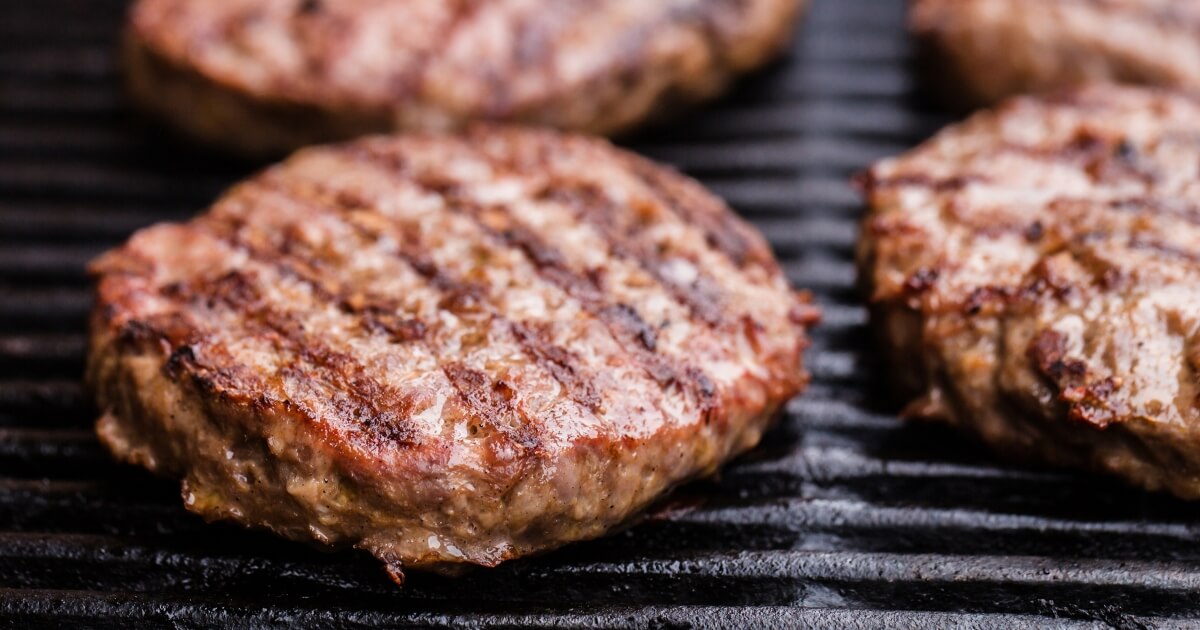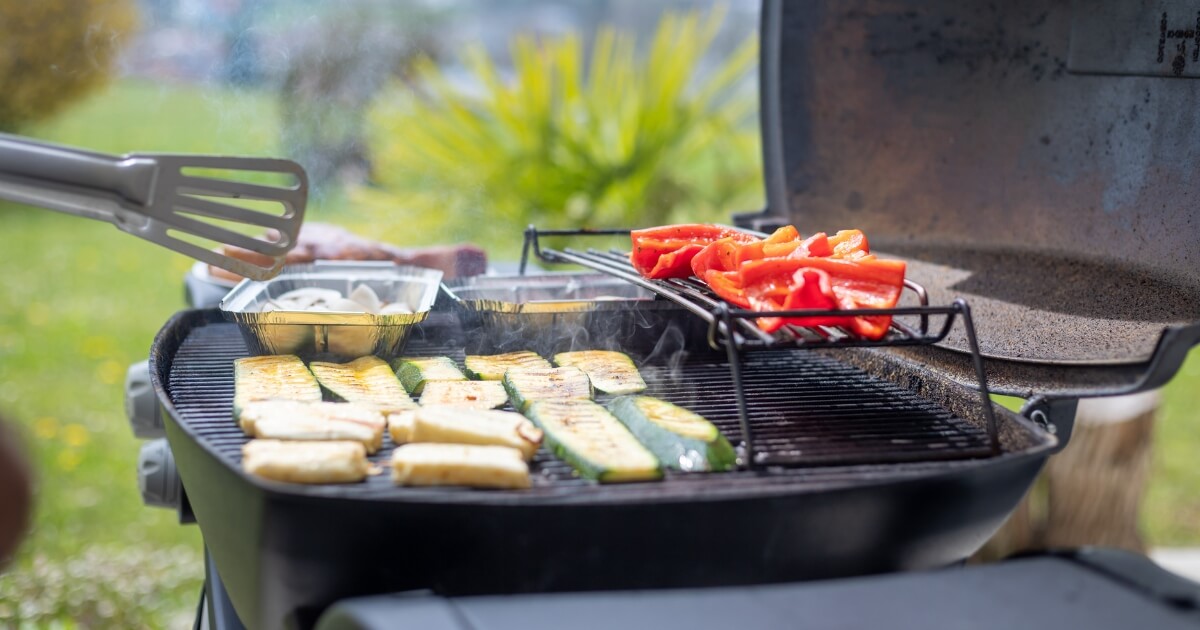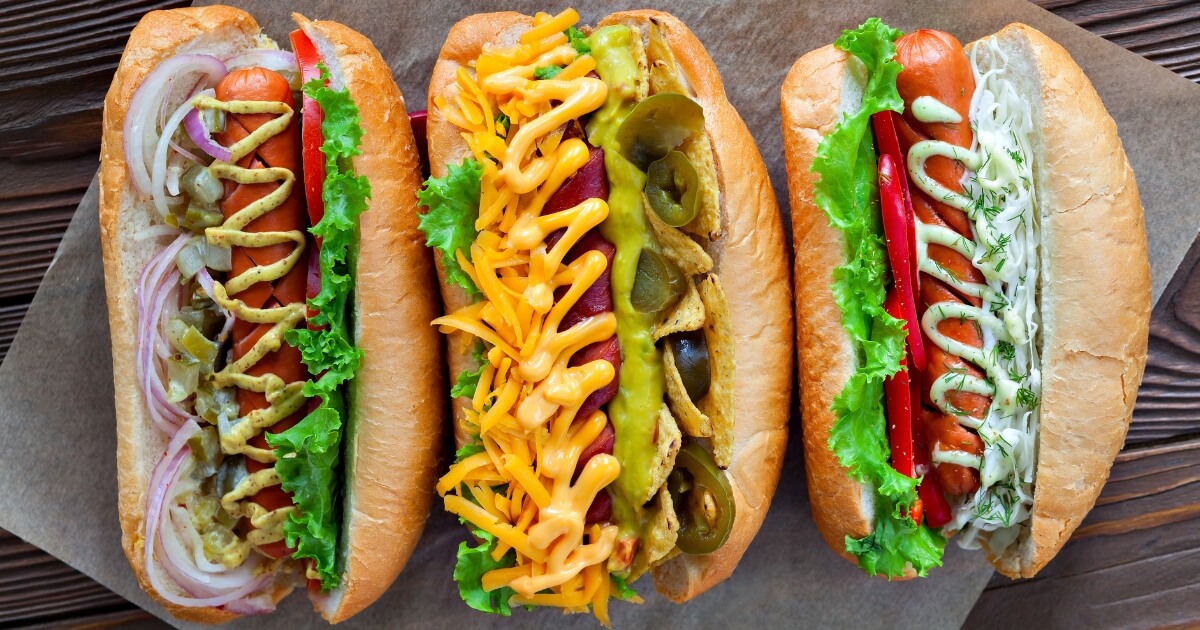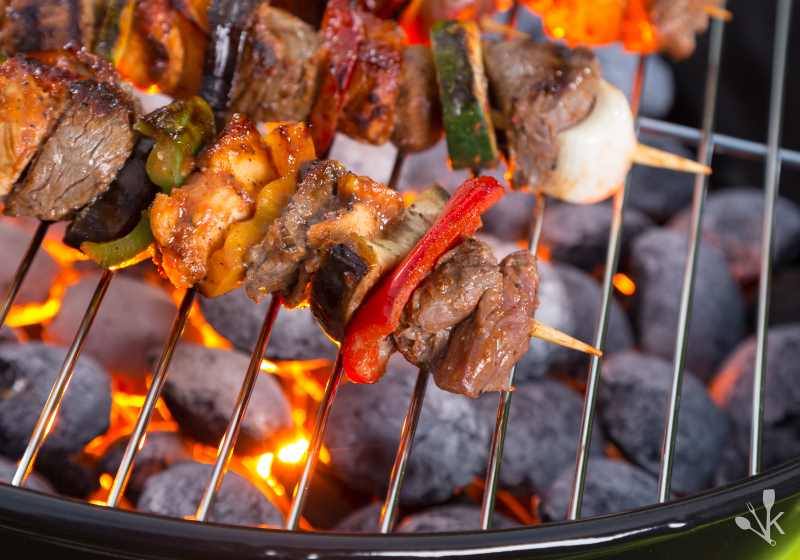Although most people think grilling and barbecuing are interchangeable cooking methods, there are actually quite marked differences between the two.
To get the most nutritious and tasty food, you need to know the main points of difference between the methods, what foods to use with each style, and some key tips.

Look no further, we’ve got all your bases covered in our guide to barbecuing and grilling.
What Is The Difference Between BBQing And Grilling?
People often refer to any and all outdoor cooking as barbecuing, but technically, the two methods are very different and produce contrasting styles of food. There are two important factors that separate the two – heat and time.
- Grilling uses higher temperatures and cooks your food quickly, directly over the heat source.
- Barbecuing involves much lower heat and longer cooking times – the heat source isn’t directly underneath your food – instead, your items are heated by the ambient temperature.
See our reviews of the best meat thermometers for grilling to help you stay in the proper temperature range.
Barbecuing is done with a closed lid, so your cooking is surrounded with hot air, whereas when you grill, the lid is up, and the heat is only coming from below.
Although some devices can double as a grill and a barbecue, if the device only has one burner, it’s technically a grill.
When it comes to BBQ vs grill, it’s all a matter of how much time and effort you are prepared to put into your meals.
What Is Barbecue?
If you’re after a simple barbecue definition, it can be summed up in three words: low and slow.
Barbecuing is a much-loved art form, more for the cook who likes to take their time perfecting their craft, and not so well-suited for a lunch time get-together with friends – it’s all about the long-game.
When you barbecue, you are cooking your food on a lower heat – around 200-300 degrees F – for a long time. You cook with the lid down, allowing heat to circulate, similar to cooking in an oven. The coals or flame in a barbecue will either be far below your food, or off to the side.
This method is ideal for tougher meats and larger cuts that need a slower, lower process to break down tough components and retain their moisture.
True BBQ connoisseurs cook their meat for countless hours to get a flavorful and juicy result. Cooking times can vary widely, between 2 and 18 hours, depending on how big and/or tough your chunk of meat is.
Best Foods To BBQ
Let’s face it, when people imagine a BBQ, they think about barbecuing meat. Tougher and larger cuts of meat are well-suited to this low and slow cooking method, such as:
- Pork shoulder
- Ribs
- Beef brisket
- Whole chickens or turkeys
- Tri-tip
What Is Grilling?
The three words that summarize up the grill definition are: hot and fast.
Grilling uses intense heat – between 500 and 700 degrees F – which results in faster cooking times of around 5-20 minutes.
When grilling, the lid is kept open and your food is cooked directly above the single heat source – you’ll need to flip your items over to ensure they cook evenly.
That mouth-watering, distinctive grilled flavor comes from fat dripping down into the heat source, producing smoke that will slightly imbue your food with subtle flavors. Grilling quickly creates a crust around your food, sealing in the moisture.
The best option if you want your food to be ready quickly with no fuss, most items on the grill will be ready in around 5-20 minutes.
Best Foods To Grill
Because the super-high heat of a grill will cook your meat quickly, it’s best to choose smaller cuts of meat that are naturally moist and tender, for example:
- Steak
- Pork chops
- Seafood
- Hamburgers
- Sausages
- Chicken Breasts
- Vegetables
Advantages Of Grilling
- High heat means rapid cooking times
- Portable – you can grill almost anywhere
- Lower fat option than frying, extra fats drips away from your food
- Veges cooked on the grill retain more of their nutrients than boiling or frying
- Huge variety of food types can be easily grilled
- Your food has extra flavor, as grilling caramelizes the natural sugars present
- Fast and easy clean-up
Chargrilled vs Grilled
The difference here is simple: chargrilled foods are raised above the cooking surface, and these raised surfaces endow food with that distinctive striped, charred pattern that looks and tastes oh so delicious.
In opposition, flat grills are flat, heated surfaces that the food sits directly on.
Chargrills lift food away from dripping fat and oils, meaning the resulting food is a lot healthier. However, because the liquid drains out, it may end up a little bit drier than if you use a flat grill.
Flat grills have better heat distribution across the surface, so you have a little bit more control over your cooking. You can even cook pancakes and eggs straight on flat grills – if you tried this on a chargrill it would be an epic failure.
The biggest difference is that if you choose not to chargrill, you’re missing out on that extra kick of authentic, smoky flavor in your food.
Grilling And Health
Fat that drips down onto your hot charcoal or wood chips transforms into smoke. Both the charred crust around your meat, and the smoke produced by the dripping fat are rumored to be a wee bit hazardous to your health.
But as with anything, moderation is the key. You can still enjoy delicious grilled meat without going so far as to blacken it, or just refrain from eating charred meat every day.
The good news is that some studies show that generously marinating your meat can reduce the carcinogens present.
Smoking
Smoking is the same basic concept as barbecuing; in fact, smoke is an inherent component in barbecuing, and to a lesser degree, grilling.
However, the temperature is often even lower – between 68-176 degrees F – and cooking times can extend for days or even weeks. The smoke produced is used to help infuse flavor into meat.
Usually, the smoke and heat is created in one chamber and then introduced to another chamber that holds the meat. Popular woods for smoking meat include hickory, cherry, and apple wood – each producing its own particular flavor.
Smoking takes patience and dedication, and is considered to be an art form. Die-hard smokers use a cold-smoking method over the course of days or weeks. You can use a dedicated smoker, or for those who aren’t so finicky or lack patience, you can give it a go in your BBQ or purchase a pellet smoker.
See our Smoking meat for beginners guide for the best techniques for BBQ smoking.
What Fuel Should I Use With My BBQ Or Grill?
Charcoal
When barbecuing, the key to turning tough, chewy cuts of meat into tender chunks that practically fall off the bone, is maintaining an even, low temperature over time. Charcoal is the ideal fuel for this – it burns cleanly and evenly.
There are two kinds of charcoal: ‘lumps’ or ‘bricks’.
- Lump charcoal is made entirely from charred wood, so lack any nasty chemicals. However, they come in a variety of sizes, which can make it hard to keep the temperature even.
- Charcoal briquettes typically have added chemicals to help maintain their shape. Because they are all the same size, they produce a steady heat. See the guide on the best charcoal briquettes to use for grilling.
Wood
The fuel of choice for hardcore barbecue enthusiasts, wood is hugely desirable because it provides that delectable smoky flavor. You can use it on its own, or add wood chunks or chips to your charcoal base.
- Hardwoods such as oak and hickory give off a beautiful medium to strong fragrant smoke.
- Softer woods like alder and maple give pork and salmon a sweet flavor.
- Fruit-based wood such as cherry and apple give a stronger, fruity flavor that is perfect for chicken, turkey and pork.
Wood shavings burn rapidly, whereas wood chips last a little longer. Your best bet is larger chunks of wood (around fist size) which burn more slowly, giving you greater control over your smoke density – you can add or remove chunks to achieve the desired smoky effect.
Make sure your wood has been left to sit for at least two to three months. Fresh wood will produce thick, black smoke and an unpleasant taste.
If you want your wood to burn a little slower and last longer, soak it in water overnight before throwing it in the BBQ or grill.
Propane
An inexpensive and readily available option, propane gas tanks are easy to get hold of and refill. Although a cheap and easy fuel which burns cleanly at high temperatures, propane doesn’t provide the same distinctive flavors as charcoal and wood do.
SEE ALSO: How To Light A Gas Grill
10 Foods You Hadn’t Thought Of To Grill Or BBQ
Whether you’re barbecuing or grilling, both words conjure up visions of plates stacked high with juicy steaks and steaming sausages, with the smell of meat wafting through your backyard.
But vegetarians don’t need to miss out on all those backyard cookouts in the summer months – in fact, there’s a host of delicious foods that everyone can enjoy straight from the grill/BBQ.
- Pizza
- Corn
- Eggplant
- Avocado
- Brie
- Pineapple
- Banana chocolate split
- Strawberries
- Capsicum
- Squash
Grilling and BBQ Tips
- Use an onion to clean the grill. While your grill is still hot, slice an onion in half and use it to clean the metal- as a bonus, it will add some flavor the next time you cook. Don’t forget to wear a pair of your best BBQ gloves to help prevent burns.
- The most common reason that meat sticks to the grill is that it’s not ready to be moved. Once the proteins have cooked fully, the meat will “unstick” itself. If you are impatient and try to move it beforehand, you will end up tearing the meat.
- When purchasing a BBQ or grill, they are often sold with different attachments and features. Think about your intention: do you really need the smoker attachment, a spit roaster, or a side burner? Those can add hundreds of extra dollars on top of the base price.
Whether you are barbecuing, grilling or smoking, it is a bit of an art and takes time to master. To help you impress friends and family, check out all our BBQ and grilling guides, especially our BBQ safety tips.
While most popular in the summertime, BBQs and grills are also fired up during the colder months of the year.
Whether you prefer to do it in the comfort of your own kitchen, in the familiarity of your backyard, or further afield in the great outdoors, there’s no reason you can’t enjoy your favorite grilled or barbecued meats and vegetables all year around, even in the rain.











